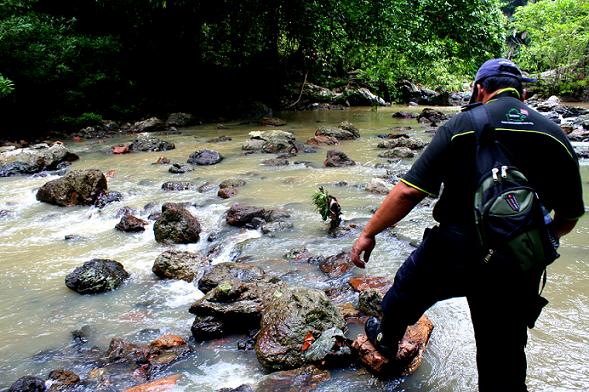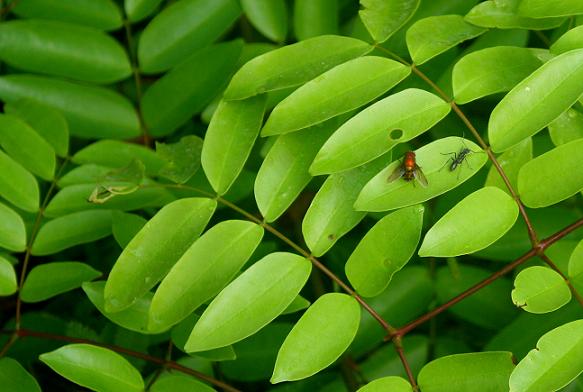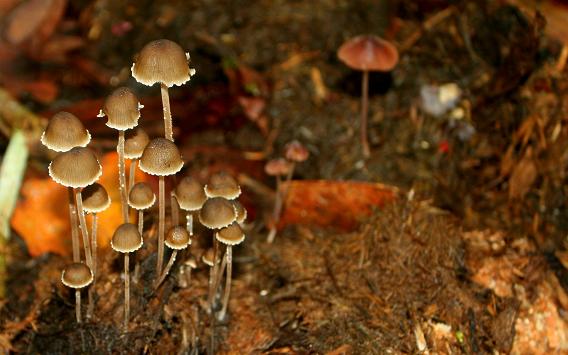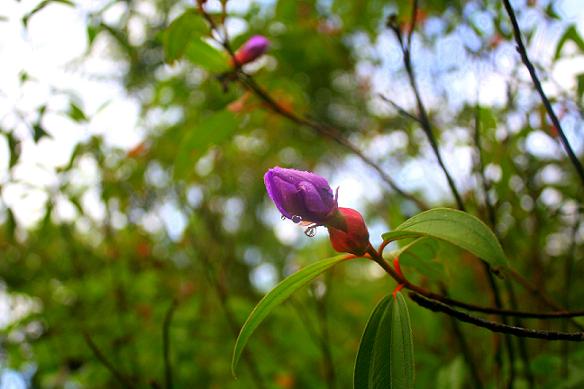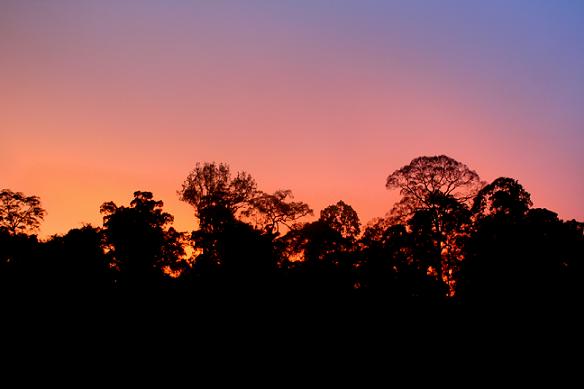The vehicle stopped on the way into Tabin Wildlife Reserve as a troop of pig-tailed macaques began making their way across the road. In a flash a domestic dog, which may or may not have been ‘ownerless’, ambushed the group. Chaos erupted as the big predator fell upon the community. As quickly as it began it was all over and the dog was rushing over with an infant monkey in its mouth, leaving the macaques’ screeching out their helplessness.
As my uncustomary welcome to Tabin Wildlife Reserve shows: the park is a meeting of two worlds. On the left side of the road leading into the reserve is a massive oil palm plantation, on the right is the rainforest and the many species the reserve protects. Tabin, therefore, gives the visitor a unique up-close view of the debate raging in Borneo and throughout much of Southeast Asia over conservation and environment versus oil palm plantations.
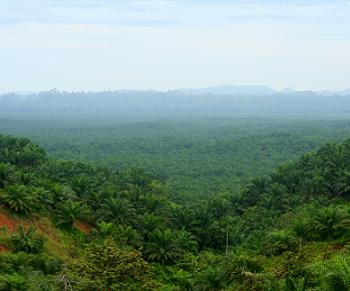 The Tabin landscape: palm oil in the foreground, rainforest in the background. Photo by: Jeremy Hance. |
Despite its proximity to oil palm plantations, which border three sides of the park, the reserve is vast enough (approximately 112,000 hectares) to support a startling amount of biodiversity, including a number of big species, such as Bornean elephants, the banteng, Sunda clouded leopard, Bornean orangutans, sun bear, gibbons, and, most importantly, some of the last individuals of the nearly extinct Bornean rhinoceros, a subspecies of the Sumatran rhino. But, of course, one should remember prior to becoming too excited that this is a rainforest, and species—even big species—are extremely hard to see.
What you can expect: a multitude of birds including several species of hornbill, lovely insects, beautiful flowers, macaques and maybe gibbons. If you take a night drive you’ll have a good chance of seeing leopard cats, bearded pigs, civets, and owls. Count yourself lucky to see orangutans or elephants, the others—clouded leopard, banteng, and sun bears—are very unlikely. My guide, who lived in the area his whole life, had only seen the Bornean rhino four times. Considering the few individuals left on the whole island—forty or less—you should consider this the unlikliest sighting of them all.
WILDLIFE
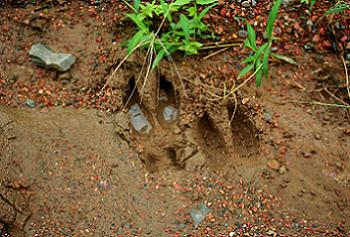 Footprints of the elusive Southeast Asian forest cattle, the banteng. Photo by: Jeremy Hance. |
Visitors come to Tabin from around the world for one reason: to see Borneo’s incredible wildlife, both flora and fauna. From the hopes of catching a glimpse of the island’s biggest animal (the Bornean elephant) to spying a good number of the reserve’s over two hundred and fifty bird species to admiring the stately dipterocarps.
There is an incredible amount of biodiversity in the park and the guides are adept at pointing it out: within meters of the lodge in my first two hours visiting my guide showed me one of the world’s smallest squirrel (the least pygmy squirrel), a flying dragon, and elephant droppings which sported lovely micro-communities of fungi.
On afternoon and morning drives birds are the main targets, since many of them are readily seen. Tabin has eight species of hornbill; in my time there I was fortunate enough to see six of them. I also saw kingfishers, eagles, owls, and the endangered Storm’s stork. One of the avian highlights was a very lucky sighting of the Great Argus pheasant: a female had stolen away from its mate and we watched her enjoy her freedom until the male came calling plaintively. If you consider birds largely uninteresting, tropical rainforests will cure you of this malady.
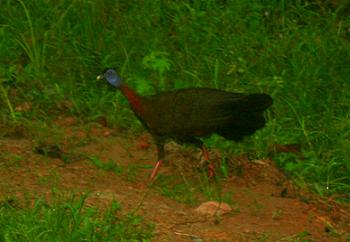 A running female Great Argus pheasant. Photo by: Jeremy Hance. |
Night drives are particularly fascinating, especially for someone who has visited the tropics before and is used to not seeing much in the way of good-sized mammals. This is due to the proximity of the oil palm plantations: there are a few notable species which live in the forest but at night feed in the oil palm plantations, either on the plantation’s rodents or the fruit itself. The vast majority of species do not utilize oil palm plantations—hence the biodiversity crisis in the region—but at Tabin you are very likely to see the few that do, especially on night drives. These include leopard cats (the only species our of five of cat in Borneo that is not threatened with extinction), bearded pigs, Malay civet, and if you’re lucky owls.
These rides are endlessly thrilling, as bearded pigs will barrel out in front of your vehicle in family groups and leopard cats—gorgeous little predators—will stare back at you in the searchlight with emerald eyes. Returning one night we saw the world’s tiniest hoofed animal: the Lesser mouse deer, which was a true highlight for someone who is fascinated by both miniatures and big-atures.
Sometimes wildlife encounters happen when you least expect them. One hot afternoon I was settling myself with a beer and Charles Dickens on my personal porch when I happened to feel a presence near me. Turning I came face-to-face with the large, beautiful, and endangered Bornean gibbon. I had seen them from afar and listened to their weird and wonderful calls, but there’s nothing like being eye-to-eye. We sized each up for awhile and then the gibbon took off into the trees.
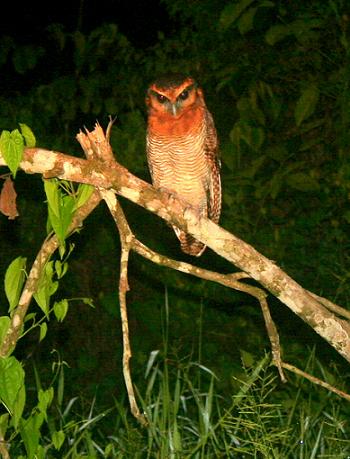 An owl. Photo by: Jeremy Hance. |
I was told later by some guests that the gibbons and macaques would often climb onto guests’ verandas seeking food. If they were really brave they would try the doors and, if unlocked, ransack your room. So, warning in advance: keep your room locked! Don’t worry about your safety though: as the saying goes ‘they are far more scared of you than you are of them’.
CONSERVATION AND PALM OIL
As stated earlier, Tabin Wildlife Reserve gives one a real sense of the dilemma in Borneo and Southeast Asia over conservation and oil palm plantations. There is little question that plantations, rather than conservation, currently dominate corporate and government interests. In the past decades oil palm plantations have replaced much of the tropical forest in the area: it is estimated that nearly one-fifth of Sabah is covered by oil palm, a total of 1.4 million hectares. Take note of this—and don’t be afraid to ask questions—as it is one of the most interesting aspects of visiting Tabin.
Aside from having a good chance of seeing some of the few species that utilize oil palm plantations, the park also represents what has been lost in the region, easily seen when flying in the Lahad Datu: just look for the endless sprawl of monotone oil palm. Company executives argue that the land they convert into oil palm plantations has already been leveled by logging. But, a recent study in Conservation Letters found that 55-59 percent of palm oil plantations in Malaysia built between 1990 and 2009 occurred on forested land. In all it has been estimated that in Sabah forest cover has declined by nearly 90 percent from 1975-1995, likely due to a combination of logging and oil palm.
In addition by converting even logged land to oil palm one forgoes the possibility of the land eventually returning to forest.
Some oil palm proponents also claim that the oil palm plantations helps rainforest animals and point to the (few) species that one can see moving in Tabin from forest to plantation as examples. However, a study has shown that biodiversity drops 83 percent when a forest is converted into an oil palm plantation. In addition, claims that orangutans benefit from oil palm plantations have been soundly condemned by researchers. The Bornean orangutan is considered endangered due mostly to habitat loss: Sabah has lost half of its orangutans in 50 years.
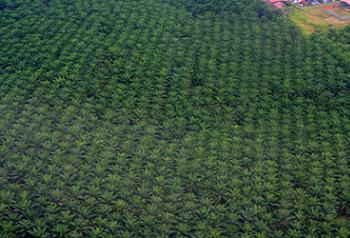 Oil palm plantation from the air in Sabah. Photo by: Jeremy Hance. |
Deforestation is also a major contributor to the area’s greenhouse gas emissions. In fact, Indonesia—the world’s largest producer of oil palm (Malaysia is second)—is the world’s third largest emitter of greenhouse gases largely due to rampant deforestation in part for oil palm plantations.
There is no question that oil palm has been a boon to Malaysia’s economy (in 2008 exports of palm oil brought in 18.7 billion US dollars), including providing revenue for federal and state government and aiding rural development. However claims that oil palm has saved the nation from poverty hide part of the truth: one visible in the rundown worker’s huts that one can see at Tabin.
Although company executives have claimed that oil palm plantation workers are paid above the poverty line, worker representatives point out that the average pay is below the state’s poverty line. Many oil palm plantation workers in Sabah are immigrants from the Philippines and Indonesia looking for a better life, but still trapped in poverty. Despite making billions in profits, the oil palm industry has even had difficulty finding workers due to their low pay and the rough, difficult work environment.
RESORT
 Hornbill at dusk. Photo by: Jeremy Hance. |
The Tabin resort is lovely and luxurious, yet still comfortably set in its natural surroundings. For someone used to camping and budget, I was quite taken aback by the place, and at times the silly frills. That being said the cabins are lovely, simply, to look at. I was most taken aback by the fact that here deep in the wilderness there was air conditioning. Of course, for the eco-conscious, sweating a bit and seeking shade (as well as cold beers) is preferable to turning on the air in the middle of the jungle.
The food, served in a wonderful open-air dining area, is superb. I am a vegetarian and I ate better at the reserve than I did on much of my trip. The only issue with the food is sometimes there was far more than I could eat.
The reserve is stocked with a full bar, including a variety of cold beers and full wine bottles if you like, which makes celebrating an especially good sighting all that much more fun.
The reserve will set-up itineraries according to your taste. They offer a number of them on their website, including trips particularly for birders, overnight visits to massive mud volcanoes where if you’re lucky animals will come to eat the clay, a variety of jungle hikes and drives, and even a rhino conservation program. I would suggest staying at least for three nights—two full days—to make the trip worthwhile, if you can afford it (both time-wise and budgetary) longer is better.
GEAR AND PREPARATIONS
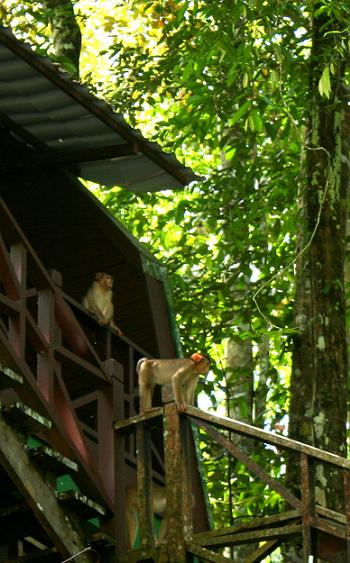 Macaques hanging out at a cabin. Photo by: Jeremy Hance. |
While the tropical forest is hot and humid, nights and early mornings can be cool, so pack something warm—just in case. Also, pack a poncho or good rain coat and a swimsuit if you like swimming in tropical pools. Sunscreen, a wide-brimmed hat, insect repellent, and good, preferably waterproof, hiking shoes are necessary as well.
No need to worry about food, snacks, alcohol, or bottled water: it’s all provided.
A camera and binoculars are a must. If you want some really good photos do what I didn’t do: rent or buy a big lens for your camera. Also, I would suggest a bird or wildlife book on the area. Your guide will probably have one, but it’s nice to have one of your own for identifying and reading about the species you encounter.
You’ll have a good amount of free time in the hot afternoons, so I recommend a good book.
Finally, make sure you have your malaria pills and your correct vaccines before leaving. It’s probably best to have a prescription for fighting traveler’s diarrhea too.
GETTING THERE
Tabin Natural Reserve is in the state of Sabah, the nation of Malaysia, and the island of Borneo. The capital of Sabah is Kota Kinabalu—and this is where most international flights arrive—but that is in the north of Sabah, while Tabin is in the South. Therefore to reach this area one usually flies to Lahad Datu (there are several flights everyday) where representatives of the reserve are happy to pick you up and drive you out to the reserve.
For more information: Tabin Wildlife Reserve website.
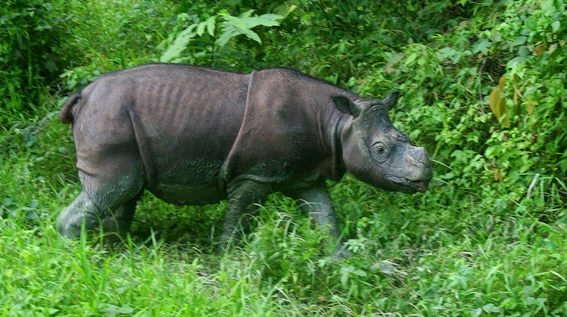
Tam, one of the last Bornean rhinos, wandered into a oil palm plantation after his foot was injured by a snare. He is now being kept in captivity in hopes to start a breeding population. Photo by: Jeremy Hance
Trekking in Tabin. Photo by: Jeremy Hance.
Small denizens, like ants and flies, make up much of Tabin’s incredible biodiversity. Photo by: Jeremy Hance.
Bornean elephant dung sports micro-communities of fungi. Recently a researcher discovered tiny species of frogs living in elephant dung in Southeast Asia. Photo by: Jeremy Hance.
Flora in Tabin. Photo by: Jeremy Hance.
Tabin rainforest at sunset. Photo by: Jeremy Hance.
Related articles
Face-to-face with what may be the last of the world’s smallest rhino, the Bornean rhinoceros

(12/01/2009) Nothing can really prepare a person for coming face-to-face with what may be the last of a species. I had known for a week that I would be fortunate enough to meet Tam. I’d heard stories of his gentle demeanor, discussed his current situation with experts, and read everything I could find about this surprising individual. But still, walking up to the pen where Tam stood contentedly pulling leaves from the hands of a local ranger, hearing him snort and whistle, watching as he rattled the bars with his blunted horn, I felt like I was walking into a place I wasn’t meant to be. As though I was treading on his, Tam’s space: entering into a cool deep forest where mud wallows and shadows still linger. This was Tam’s world; or at least it should be.
Video: Sunda clouded leopard caught on film for the first time
(02/10/2010) Carnivore researchers have captured the first footage of the Sunda clouded leopard (Neofelis diardi) in Malaysia. The island’s largest predator was only proclaimed a unique species in 2006 when genetic evidence and analysis of its markings proved it was distinct enough from its mainland relative—the clouded leopard (Neofelis nebulosa)—to be considered a new species. The recent classification has prompted renewed interest in this elusive and threatened cat.
Orangutans vs palm oil in Malaysia: setting the record straight

(01/16/2010) The Malaysian palm oil industry has been broadly accused of contributing to the dramatic decline in orangutan populations in Sabah, a state in northern Borneo, over the past 30 years. The industry has staunchly denied these charges and responded with marketing campaigns claiming the opposite: that oil palm plantations can support and nourish the great red apes. The issue came to a head last October at the Orangutan Colloquium held in Kota Kinabalu. There, confronted by orangutan biologists, the palm oil industry pledged to support restoring forest corridors along rivers in order to help facilitate movement of orangutans between remaining forest reserves across seas of oil palm plantations. Attending NGOs agreed that they would need to work with industry to find a balance that would allow the ongoing survival of orangutans in the wild. Nevertheless the conference was still marked by much of the same rhetoric that has characterized most of these meetings — chief palm oil industry officials again made dubious claims about the environmental stewardship of the industry. However this time there was at least acknowledgment that palm oil needs to play an active role in conservation.
Photos: new bird discovered in well-known rainforest in Borneo

(01/14/2010) The Danum Valley Conservation Area in Sabah, Malaysia is a huge draw for tourists and scientists; a research station has been operating in Danum Valley since 1986. But the rainforest still has surprises left: in June two employees with a tour company named Field Guide came upon every ornithologist’s dream, a bird species entirely unknown to science.
Coal plant could damage rainforest reserves, coral reefs, palm oil plantations in Malaysian Borneo
(12/20/2009) A proposed coal-fired power plant in Malaysian Borneo could damage the region’s world-renowned coral reefs, pollute air and water supplies, open Sabah’s biodiverse rainforests to mining, and undermine the state’s effort to promote itself as a destination for “green” investment and ecotourism, warn environmentalists leading an effort to block the project. The scheme, which is backed by the federal Tenaga Nasional Berhad and state energy company, Sabah Electricity Sdn. Bhd, has faced strong opposition and already been forced to re-locate twice since it was conceived more than two years ago. The 300-MW plant is now planned for a coastal area that is situated in the middle of the Coral Triangle/Sulu Sulawesi Marine Ecoregion, an area renowned for astounding levels of biodiversity.
Video: rare footage of the sun bear, the world’s smallest, making a nest in the canopy
(12/06/2009) Sun bear expert, Siew Te Wong, has captured rare footage of the world’s smallest bear making a nest high in the canopy. The sun bear in the video is a radio-collared individual that Wong is keeping tabs on in Borneo.
Photos: Palm oil threatens Borneo’s rarest cats

(11/04/2009) Oil palm expansion is threatening Borneo’s rarest wild cats, reports a new study based on three years of fieldwork and more than 17,000 camera trap nights. Studying cats in five locations—each with different environments—in Sabah, Malaysian Borneo, researchers found that four of five cat species are threatened by habitat loss due to palm oil plantations. “No other place has a higher percentage of threatened wild cats!” Jim Sanderson, an expert on the world’s small cats, told Mongabay.com. Pointing out that 80 percent of Borneo’s cats face extinction, Sanderson said that “not one of these wild cats poses a direct threat to humans.”
Emotional call for palm oil industry to address environmental problems
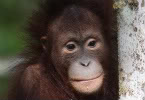
(10/21/2009) During what was at times an emotional speech, Sabah’s Minister of Tourism, Culture, and Environment, Datuk Masidi Manjun, called on the palm oil industry to stop polluting rivers and work with NGOs to save orangutans and other wildlife. He delivered the speech on the first day of an Orangutan Conservation Colloquium held in early October in the Malaysian state of Sabah on the island of Borneo.
Palm oil industry pledges wildlife corridors to save orangutans

(10/03/2009) In an unlikely—and perhaps tenuous—alliance, conservationists and the palm oil industry met this week to draw up plans to save Asia’s last great ape, the orangutan. As if to underscore the colloquium’s importance, delegates on arriving in the Malaysian State of Sabah found the capital covered in a thick and strange fog caused by the burning of rainforests and peat lands in neighboring Kalimantan. After two days of intensive meetings the colloquium adopted a resolution which included the acquisition of land for creating wildlife buffer zones of at least 100 meters along all major rivers, in addition to corridors for connecting forests. Researchers said such corridors were essential if orangutans were to have a future in Sabah.
Issues around palm oil development prove complex, controversial
(08/12/2009) A new report from published by the Center for International Forestry Research (CIFOR) highlights the benefits — and controversies — of large-scale expansion of oil palm agriculture in Southeast Asia. The review, titled “The impacts and opportunities of oil palm in Southeast Asia: What do we know and what do we need to know?”, notes that while oil palm is a highly productive and profitable crop, there are serious concerns about its environmental and social impact when established on disputed land or in place of tropical forests and peatlands.
